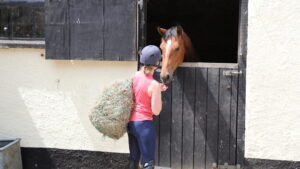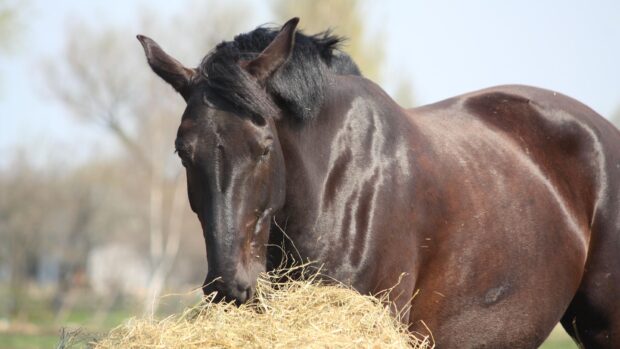Feeding a horse with gastric ulcers in the right way is key for their health and comfort. Gastric ulcers can affect any horse or pony of any breed or any age because the horse’s stomach constantly secretes acid. Horses need to chew regularly to produce enough salvia to help neutralise this acid – and without frequent intakes of forage, the acidity increases and they are at a greater risk of developing ulcers.
“Approximately 90% of racehorses and up to 60% of competition horses are thought to have gastric ulcers. Although diet is just one risk factor, appropriate nutritional management helps to reduce the risk and severity of gastric ulcers,” says Sarah Nelson, Spillers nutritionist. Recent studies have also shown that 37% of leisure horses are also affected, so this is a problem for all horse owners.
What to feed a horse with gastric ulcers
A horse with gastric ulcers should receive a high-fibre, high-forage diet that contains little or no whole cereal grains. Their total daily forage intake should be a minimum of 1.5% of their bodyweight. On average for a 500kg horse without access to grazing this equates to approximately 9kg of hay (unsoaked weight) or 10-12kg of haylage.
Some feeds suitable for horses with gastric ulcers have the BETA EGUS Approval Mark, so this is a simple way to identify some safe options.
A horse’s diet should contain less than 1g of non-structural carbohydrate (starch and sugars) per kilogram bodyweight per meal and ideally less than 2g of starch per kilogram bodyweight per day. For a 500kg horse this is equivalent to less than 500g of NSC per meal and ideally less than 1kg of NSC per day.
“Starch, such as found in concentrated cereal feeds, is strongly associated with an increased risk of gastric ulcers. Therefore, stick to the high-fibre diet, supplemented to balance the micronutrients. If additional energy is required then this is best fed through a high-oil diet, which is shown to be beneficial for the ulcer-prone — and don’t forget to balance with vitamin E,” says Kate Hore, head nutritionist at NAF.

For those horses and ponies who only eat forage, feeding oil or one of the best feed balancers can be a valuable addition to their diet.
“Balancers provide a concentrated source of vitamins, minerals and quality protein, but due to the low feeding rate, a negligible level of energy, starch and sugar,” says Sarah.
Saliva provides a natural buffer to a horse’s stomach acid and horses only produce saliva when they chew so maximising forage intake is key.
“The sooner we all feed our horses more naturally, the sooner we can make many equine health issues, including ulcers, a thing of the past. That means not only feeding the high forage diet, but also maximising turnout as much as possible, to encourage good gut motility, as the horse’s digestive system evolved to work to its best when grazing and gently moving around,” concludes Kate.
When to feed a horse with gastric ulcers
“Horses are designed to eat little and often and therefore should receive ad lib forage; research has proven that there is a risk factor for the development of ulcers if there is absence of forage in a horse’s diet for over six hours,” explains Katie Williams, technical and product development manager at Dengie.
“While this can be difficult to avoid overnight, try putting multiple haynets around your horse’s stable or if someone goes to the yard later in the evening than you, ask them to give your horse a haynet so the horse has the shortest possible time without forage.”
You can also use small-holed haynets and slow feeders to extend your horse’s eating time, which will help reduce the time he’s without if he tends to finish his ration.
Adding short chopped fibre, ideally containing alfalfa, to every meal can be hugely beneficial as the high protein and calcium content in alfalfa is thought to help buffer stomach acid.
“It is also advisable to feed a handful of chaff or forage or give a horse a haynet 20-25 mins prior to exercising to help line the horse’s stomach and stop the acid from splashing around while the horse moves,” adds Katie.
Feeding to prevent gastric ulcers
As the diet is the main contributing factor to gastric ulcers, feeding your horse as naturally as possible will go along way to helping prevent them.
Different types of forage should form the majority of your horse’s diet to provide enough fibre to buffer the stomach acid. If you need to feed for additional energy or condition, choose concentrates that are high in fibre and low in starch. There are also gastric supplements that are formulated to help balance the stomach’s pH.
If you give your horse a bucket feed with more than just a forage replacer, split these into smaller meals where possible and ensure plenty of forage is fed in between.
Twenty-four hour turnout is ideal, but not possible for many, but keeping your horse turned out for as long as you can will support their digestive health.
Providing forage in stressful situations – for example, travelling – will also help buffer any additional acid. Feeding chaff before exercise may also help to trap acid and limit ulceration.
If you’re unsure on how to proceed or are navigating multiple issues, speak to a nutritionist for advice – most feed companies have free helplines.
You might also be interested in:

20 feeds suitable for horses prone to gastric ulcers

Gastric ulcers in horses: the important facts every owner needs to know

Balance the stomach pH – a guide to gastric supplements on the market

Subscribe to Horse & Hound magazine today – and enjoy unlimited website access all year round
Horse & Hound magazine, out every Thursday, is packed with all the latest news and reports, as well as interviews, specials, nostalgia, vet and training advice. Find how you can enjoy the magazine delivered to your door every week, plus options to upgrade your subscription to access our online service that brings you breaking news and reports as well as other benefits.




